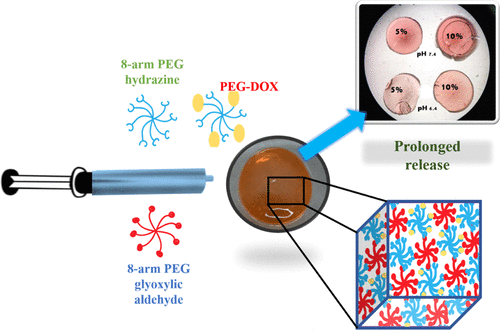当前位置:
X-MOL 学术
›
Biomacromolecules
›
论文详情
Our official English website, www.x-mol.net, welcomes your
feedback! (Note: you will need to create a separate account there.)
Glyoxylic Hydrazone Linkage-Based PEG Hydrogels for Covalent Entrapment and Controlled Delivery of Doxorubicin.
Biomacromolecules ( IF 5.5 ) Pub Date : 2019-05-07 , DOI: 10.1021/acs.biomac.9b00020 Peeyush K Sharma 1 , Yashveer Singh 1
Biomacromolecules ( IF 5.5 ) Pub Date : 2019-05-07 , DOI: 10.1021/acs.biomac.9b00020 Peeyush K Sharma 1 , Yashveer Singh 1
Affiliation

|
Precise local delivery of chemotherapeutic agents employing an injectable depot could be a promising approach to achieve spatiotemporal control over the drug release along with minimizing the challenges associated with the systemic delivery of chemotherapeutic agents. In this regard, we report the development and evaluation of a poly(ethylene glycol) (PEG) hydrogel-based drug delivery platform for the covalent entrapment and sustained release of chemotherapeutic agents. The hydrogels were fabricated by cross-linking of 8-arm PEG glyoxylic aldehyde and 8-arm PEG hydrazine using glyoxylic hydrazone linkages, without employing small-molecule cross-linkers. The hydrogels displayed pH-responsive gelation and swelling pattern along with mechanical robustness, with storage modulus of up to 1650 Pa. Owing to the reversible nature of glyoxylic hydrazone linkages, hydrogels exhibited excellent thixotropic and self-healing characteristics. Doxorubicin (DOX) was covalently entrapped into the hydrogel matrix by attaching it to 8-arm PEG hydrazine in substoichiometric ratios, prior to fabrication of hydrogels. A controlled release of up to 81.33% DOX was obtained from 5% hydrogels after 40 days at tumoral pH (6.4 ± 0.05) and only 42.87% DOX at physiological pH (7.4 ± 0.05). The 3-(4,5-dimethylthiazol-2-yl)-2,5-diphenyltetrazolium bromide assay and three-dimensional cell encapsulation studies using NIH-3T3 cell lines demonstrated the biocompatible nature of polymers as well as the hydrogel matrix. The multicellular tumor spheroid growth suppression studies demonstrated a 40.50% reduction in tumor area for the PEG-DOX conjugate, while a 29.27% reduction for hydrogel release media and 51.9% for the DOX. Both PEG-DOX and the release media were internalized into A549 cells, causing cell death. The present strategy can be employed for long-term sustained delivery of chemotherapeutic agents to locally accessible tumors or sites adjacent to tumor.
中文翻译:

基于乙醛Hy键的PEG水凝胶用于共价捕获和阿霉素的受控递送。
采用可注射的储库精确地局部递送化疗药物可能是一种有前途的方法,可以实现对药物释放的时空控制,同时最大程度地减少与化疗药物的全身性递送相关的挑战。在这方面,我们报告了基于聚(乙二醇)(PEG)水凝胶的药物传递平台的开发和评估,该平台可用于化学治疗剂的共价捕获和持续释放。通过使用乙醛酸hydr键交联8臂PEG乙醛醛和8臂PEG肼来制备水凝胶,而无需使用小分子交联剂。水凝胶显示出pH响应的凝胶化和溶胀模式以及机械强度,储能模量高达1650 Pa。由于乙醛酸键的可逆性质,水凝胶具有出色的触变性和自修复特性。在制造水凝胶之前,先以亚化学计量比将阿霉素(DOX)以亚化学计量比连接到8臂PEG肼上,使其共价键合到水凝胶基质中。在肿瘤pH(6.4±0.05)下40天后,从5%水凝胶中获得高达81.33%DOX的控制释放,而在生理pH(7.4±0.05)下只有42.87%DOX。使用NIH-3T3细胞系进行的3-(4,5-二甲基噻唑-2-基)-2,5-二苯基四唑溴化物测定和三维细胞封装研究证明了聚合物以及水凝胶基质的生物相容性。多细胞肿瘤球体生长抑制研究表明,PEG-DOX共轭物的肿瘤面积减少40.50%,而29。水凝胶释放介质减少27%,DOX减少51.9%。PEG-DOX和释放介质均被内化到A549细胞中,导致细胞死亡。本策略可用于将化学治疗剂长期持续递送至局部可接近的肿瘤或与肿瘤相邻的部位。
更新日期:2019-04-25
中文翻译:

基于乙醛Hy键的PEG水凝胶用于共价捕获和阿霉素的受控递送。
采用可注射的储库精确地局部递送化疗药物可能是一种有前途的方法,可以实现对药物释放的时空控制,同时最大程度地减少与化疗药物的全身性递送相关的挑战。在这方面,我们报告了基于聚(乙二醇)(PEG)水凝胶的药物传递平台的开发和评估,该平台可用于化学治疗剂的共价捕获和持续释放。通过使用乙醛酸hydr键交联8臂PEG乙醛醛和8臂PEG肼来制备水凝胶,而无需使用小分子交联剂。水凝胶显示出pH响应的凝胶化和溶胀模式以及机械强度,储能模量高达1650 Pa。由于乙醛酸键的可逆性质,水凝胶具有出色的触变性和自修复特性。在制造水凝胶之前,先以亚化学计量比将阿霉素(DOX)以亚化学计量比连接到8臂PEG肼上,使其共价键合到水凝胶基质中。在肿瘤pH(6.4±0.05)下40天后,从5%水凝胶中获得高达81.33%DOX的控制释放,而在生理pH(7.4±0.05)下只有42.87%DOX。使用NIH-3T3细胞系进行的3-(4,5-二甲基噻唑-2-基)-2,5-二苯基四唑溴化物测定和三维细胞封装研究证明了聚合物以及水凝胶基质的生物相容性。多细胞肿瘤球体生长抑制研究表明,PEG-DOX共轭物的肿瘤面积减少40.50%,而29。水凝胶释放介质减少27%,DOX减少51.9%。PEG-DOX和释放介质均被内化到A549细胞中,导致细胞死亡。本策略可用于将化学治疗剂长期持续递送至局部可接近的肿瘤或与肿瘤相邻的部位。













































 京公网安备 11010802027423号
京公网安备 11010802027423号